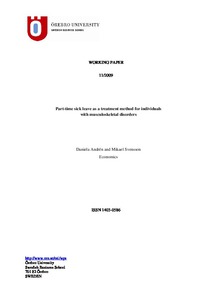Part-time sick leave as a treatment method for individuals with musculoskeletal disorders
"There is increasing evidence that staying active is an important part of a recovery process for individuals on sick leave due to musculoskeletal disorders (MSDs). It has been suggested that using part-time sick-leave rather than full-time sick leave will enhance the possibility of full recover...
| Main Authors: | , |
|---|---|
| Institution: | ETUI-European Trade Union Institute |
| Format: | TEXT |
| Language: | English |
| Published: |
Örebro University
2009
|
| Subjects: | |
| Online Access: | https://www.labourline.org/KENTIKA-19187363124919055459-Part-time-sick-leave-as-a-trea.htm |
| Summary: | "There is increasing evidence that staying active is an important part of a recovery process for individuals on sick leave due to musculoskeletal disorders (MSDs). It has been suggested that using part-time sick-leave rather than full-time sick leave will enhance the possibility of full recovery to the workforce, and several countries actively favor this policy. However, to date only few studies have estimated the effect of using part-time sick leave in contrast to full-time sick leave. In this paper the effects of being on part-time sick leave compared to full-time sick leave is estimated for the probability of returning to work with full recovery of lost work capacity and uses a sample of 1,170 employees from the RFV-LS database of the Social Insurance Agency of Sweden. A twostage recursive bivariate probit model is used to deal with the endogeneity problem. The first step estimates the probability of being assigned to part-time sick leave, and the second step estimates the likelihood of recovery with part-time sick-leave as an explanatory variable together with a set of other individual characteristics. The results indicate that employees assigned to part-time sick leave do recover to full work capacity with a higher probability than those assigned to full-time sick leave. The average treatment effect of part-time sick leave is 25 percentage points. Considering that it may also be less expensive than assigning individuals to full-time sick leave, this would clearly imply efficiency improvements from assigning individuals, when possible, to part-time sick leave." |
|---|---|
| Physical Description: | 19 p. Digital |

